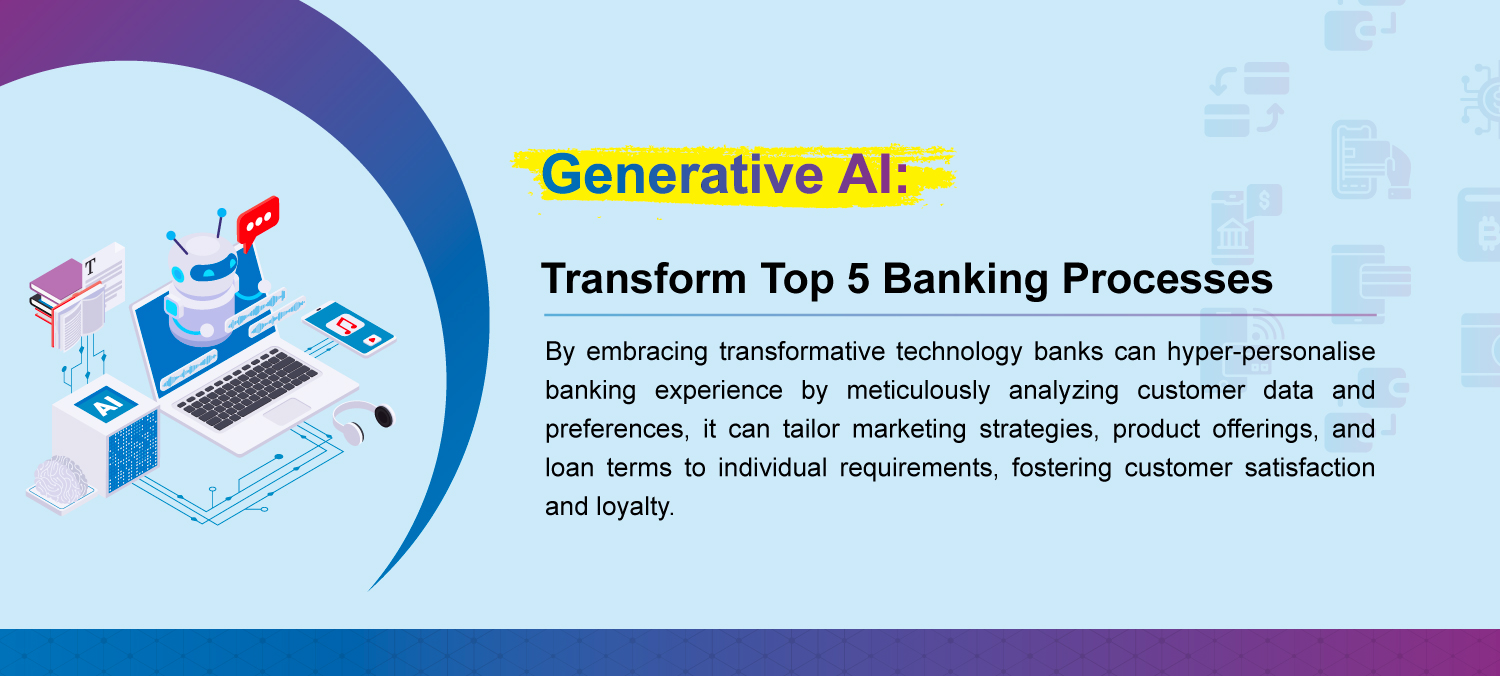Transform Top 5 Banking Processes with Generative AI
Table of content
- Transform Banking Operations with Generative AI
- Understanding the Mechanism of Generative AI
- Refined Credit Risk Assessment
- Personalized Financial Services
- Streamlined Onboarding Procedures
- Proactive Fraud Detection and Prevention
- Regulatory Compliance Automation
- The Power of Personalization Beyond Process Optimization
- Navigating Challenges and Considerations
- Conclusion

Generative AI, an innovative subset of artificial intelligence, is poised to redefine the operational paradigms of the banking sector. This technology, which focuses on the creation of data, promises to introduce a new epoch of efficiency, customization, and risk mitigation within financial institutions.
This Blog will explore the implications of generative AI on various banking operations and its potential to enhance functionality.
Understanding the Mechanism of Generative AI
At its core, generative AI leverages generative algorithms to discern patterns within extensive datasets and subsequently produce novel, yet relevant data points. This capability presents a myriad of opportunities for the banking industry.
A simplified framework illustrating the workings of generative AI includes:
- Training Data: Initially, the model is exposed to vast datasets pertinent to specific banking functions, such as customer information and market trends.
- Generative Model: This component of the AI system assimilates the data distribution.
- Discriminative Model: Serving as a critical evaluator, it distinguishes between genuine data (from the training dataset) and synthetic data.
- Iterative Learning: Both models engage in a dynamic learning process, with the generative model refining its output to appear more authentic as the discriminative model becomes more adept at discerning real from generated data.
Transform Top 5 Banking Processes With Generative AI
The integration of generative AI yields substantial benefits for banks, including process optimization and enhanced customer experiences. Key applications include:
1. Refined Credit Risk Assessment:
By systematically evaluating extensive data from diverse sources, generative AI enables a comprehensive view of a borrower’s financial status. This sophisticated analysis minimizes default risk and informs more astute credit decisions.
2. Personalized Financial Services:
Imagine a chatbot that provides tailored financial advice based on your unique financial profile. Generative AI empowers such intelligent systems to offer personalized recommendations and loan simulations, enriching the customer experience.
3. Streamlined Onboarding Procedures:
The traditionally cumbersome onboarding process can be significantly improved through automation. Generative AI can expedite document verification, data extraction, and risk analysis, facilitating a swifter and more efficient client onboarding experience.
4. Proactive Fraud Detection and Prevention:
As fraudulent strategies evolve, generative AI’s capacity to detect anomalies in transaction patterns is invaluable. By generating synthetic data that mirrors potential fraudulent activity, banks can train their AI models to identify and counteract complex schemes in real-time.
The intricate tapestry of financial regulations can be a burdensome task. Generative AI can automate the creation of reports and the interpretation of compliance directives, allowing human resources to focus on strategic tasks.
The Power of Personalization Beyond Process Optimization
Generative AI extends beyond mere efficiency enhancements, offering the potential for hyper-personalization within banking. By meticulously analyzing customer data and preferences, it can tailor marketing strategies, product offerings, and loan terms to individual requirements, fostering customer satisfaction and loyalty, which in turn drives profitability.
Navigating Challenges and Considerations
While the prospects of generative AI in banking are promising, several challenges must be acknowledged:
- Data Security and Privacy: Given its reliance on substantial data, robust security measures are essential to safeguard customer information and uphold confidentiality.
- Model Explainability and Bias: Transparency in AI decision-making is critical for fairness and regulatory adherence. Banks must ensure their systems are comprehensible and free from prejudiced algorithms.
- Talent Acquisition and Development: The effective implementation and management of generative AI necessitate specialized expertise, necessitating investment in workforce training or collaboration with AI specialists.
Conclusion
Generative AI represents a powerful tool for optimizing banking processes and creating a more customer-centric future. By addressing the challenges and harnessing the potential of this technology, banks can position themselves for sustainable growth and success in the years to come.
